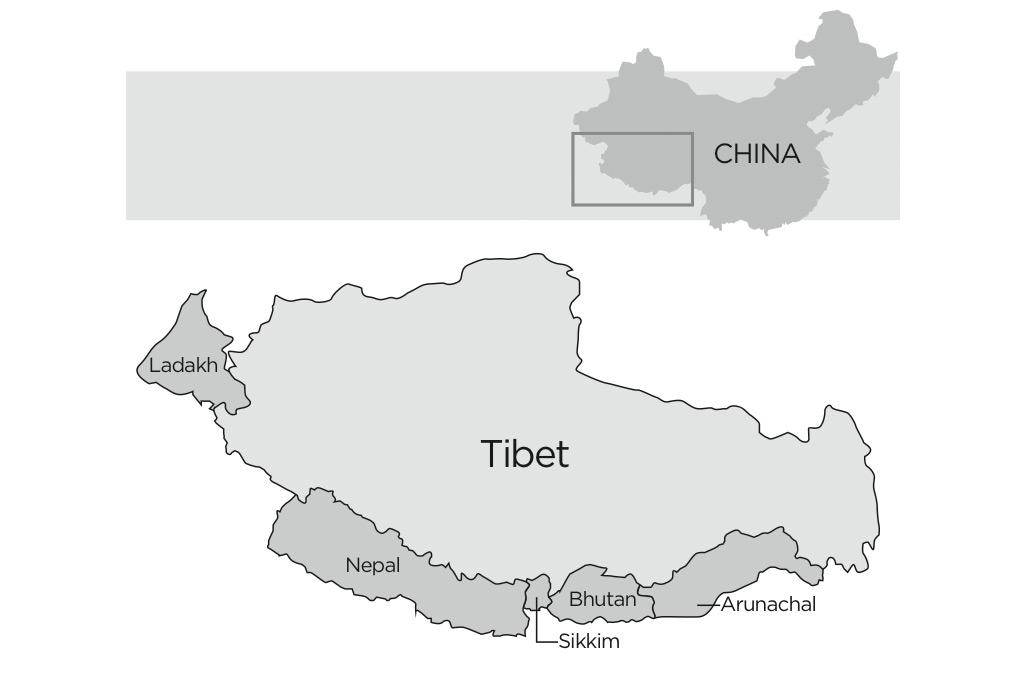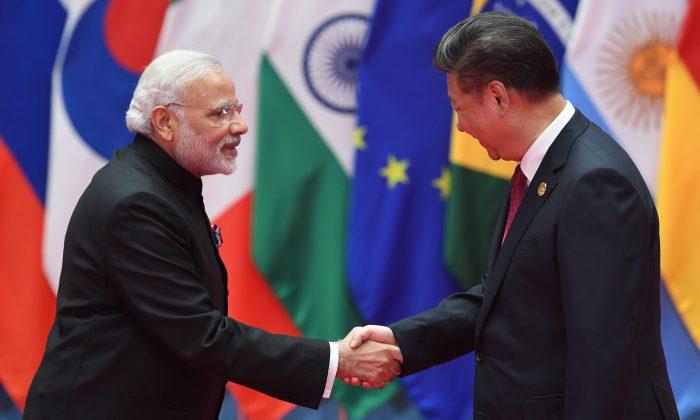NEW DELHI—As the Chinese Communist Party (CCP) celebrated its 100-year anniversary on July 1, Chinese leader Xi Jinping spoke of the “rejuvenation of the Chinese nation” and the “rise of the East.” These agendas that the regime in Beijing is likely to relentlessly pursue will have a direct effect on India, with which China’s People’s Liberation Army (PLA) has been engaged in a fierce confrontation since last year, an Indian analyst says.
Xi said, in a speech that repeated the word “rejuvenation” at least 24 times, “All the struggle, sacrifice, and creation through which the Party has united and led the Chinese people over the past hundred years has been tied together by one ultimate theme—bringing about the great rejuvenation of the Chinese nation.”
Namrata Hasija, a research fellow with the New Delhi-based Centre for China Analysis and Strategy, told The Epoch Times that India shouldn’t forget that every time Xi gives a speech, particularly since the CCP’s 19th National Congress in 2017, he mentions the “Chinese dream, which includes the rejuvenation of the great Chinese nation.”
That agenda has direct implications for India because it involves the recovery of so-called lost territory, some of which today is a part of the Indian nation, she said.
Xi said in his Party centenary speech: “The victory of the new democratic revolution put an end to China’s history as a semi-colonial, semi-feudal society, to the state of total disunity that existed in old China, and to all the unequal treaties imposed on our country by foreign powers and all the privileges that imperialist powers enjoyed in China. It created the fundamental social conditions for realizing national rejuvenation.”
Hasija said the Chinese communist leadership and Party cadres have been repeating their rhetoric about “unequal treaties” again and again, and they aren’t going to give that up.
Ladakh and Arunachal Pradesh are Indian territories that the CCP claims were taken from China by “unequal treaties” and where India has experienced repeated Chinese incursions. In Ladakh, a heavy military standoff intensified after a bloody conflict at Galwan in June 2020 left both sides with casualties.

In the Indian context, “unequal treaties” refer to the McMahon line formalized during the Shimla Convention of 1914 between Great Britain, which ruled India at the time, and Tibet, which was yet to be annexed by the CCP.
While a draft convention had been initiated between the three countries, the Chinese regime refused to accept it and didn’t sign the revised convention that was signed between Britain and Tibet. After Mao Zedong annexed Tibet, the regime overruled the mandate of the former Tibetan administration regarding the border with India that had become sovereign by then.
Hasija said that Indian policymakers should keep in mind that Xi isn’t going to back off from asserting China’s ownership of Indian territory.
“To do so, he is instilling deeply in the cadres and common people alike, that they have to continue using the three magic weapons that the CCP has. And what are they? United front, armed struggle, and Party building,” she said.
Hasija pointed to Xi’s speech, noting that he said: “We will never allow any foreign force to bully, oppress, or subjugate us. Anyone who would attempt to do so will find themselves on a collision course with a great wall of steel forged by over 1.4 billion Chinese people.”
Xi “mentioned about how they [Chinese people] should be ready for war with anyone that ‘bullies’ China, and the days of bullying China are over,” Hasija said.
“Again, he’s harping on the same narrative. ... And that is what Xi Jinping and his Party have made people believe, that [the] time has come. The East is rising, and the West is declining. And by the East rising, he’s not talking about any other country, he’s talking about China.”
Since the Galwan incident last year, India and China have had 11 commander-level meetings, in which both sides talked about withdrawing militarily from the border, but that’s not happening, she said.
“China is building massively when it comes to the border issue. Especially the India–China border, they’re building massively there,” Hasija said, citing a report stating that at least 448 pieces of military equipment, including tanks and armored personnel carriers, had been found in position near Rudok.

The deterioration of India–China relationships started much before the Galwan incident, according to Hasija. She said it began when the Chinese regime began its China–Pakistan Economic Corridor Project, a flagship Belt and Road Initiative project that passes through Gilgit-Baltistan, a disputed territory between India and Pakistan.
“If you read the Chinese-language media during the Doklam crisis, they have left no stone unturned to humiliate India, write ill about India. They attacked Prime Minister Narendra Modi, Ajit Doval [India’s current national security adviser], Sushma Swaraj [India’s then-foreign affairs minister]—everyone,” Hasija said.
Doklam refers to a military standoff between the Indian army and the PLA in June 2017 over the construction of a road the Chinese were building in Doklam, a tri-junction between India, Bhutan, and China in the central Himalayan region.
Sikkim is a northeastern Indian state that borders Tibet, Bhutan, and Nepal. It joined the Indian union in 1975, well after Indian independence from the British in 1947.

CCP’s Agendas in Tibet
The action points under the CCP’s planned “rejuvenation of the Chinese nation” also include infrastructure projects in Tibet, which mean the massive deployment of the PLA in the region, Hasija said. That has direct repercussions on India’s security, since India shares a long border with China along the Tibetan plateau.“Any project in Tibet, we all know, needs approval from the PLA, and it’s for the PLA’s benefit,” she said.
“Now all these massive infrastructure projects and events will enable the PLA to rapidly transport troops, military cargo, hardware into Tibet.”
Under the plan, the Chinese regime aims to build dams on the cross-border rivers that originate from Tibet and flow into India, and this will “adversely impact” the populations in the downstream regions in India, Hasija said, adding that the regime is building a massive dam on the river Brahmaputra or Yarlung Tsangpo in Tibet and at least 17 other dams on its lower reaches.
That’s estimated to affect at least 1 billion people in the lower riparian countries who are dependent on the river and the tributaries that feed it, she said.
“The huge influx of people and the large-scale construction activities in Tibet, including building border airports and 200 border defense villages, will certainly result in warming of temperatures. In turn, this will accelerate the retreat of glaciers and drastically reduce the flow of water in the glacier-fed rivers that irrigate the Indo–Gangetic plain, where the majority of India’s population resides,” she said.

Historical Uneasiness
Hasija said India and China have always had an uneasy relationship, and contrary to the belief that the period prior to 1950 was a “honeymoon” between the two countries, her research shows that it was never so.“When India got independence, our main problem has always been Kashmir and Pakistan. Now, India was the first non-communist country to give recognition to the PRC [People’s Republic of China]. There were, of course, calls at that time in our Parliament that we should wait,” she said.
“According to my analysis, Kashmir is a factor that contributed majorly towards Nehru’s [India’s first Prime Minister] policy toward China,” she said, adding that the Indian government would have thought that if they recognized the PRC, the Chinese leadership would support India over Kashmir.
“There’s one letter that Nehru wrote to Mohan Singh Mehta [dated] 20 September 1952. In this letter, he says that India is only threatened by Pakistan, and he is not in the least worried about China. And he’s been advised that China would be a major support to India’s stance on Kashmir in the coming years.” Mehta was India’s ambassador to Pakistan during that time.
India followed a policy of appeasement toward the Chinese regime after the annexation of Tibet for this reason, according to Hasija.
“And then China’s claim on Formosa Taiwan, of course, India always said during that time that it is an extension of the Chinese Civil War, and we are not bothered if Formosa is a part of China,” Hasija said.
The Chinese regime never supported India, Hasija said. She believes the Indian leadership wasn’t able to understand the Chinese communist leadership, and said it’s time India invests in research to understand CCP thought.
“We have hardly invested in China studies, we do not have enough scholarship on understanding and knowing Chinese,” she said, adding that India can also build new partnerships and strategic alliances to counter the Chinese agenda of “great rejuvenation.”





